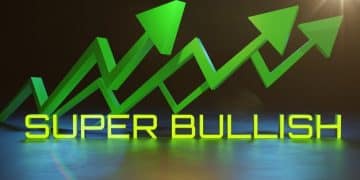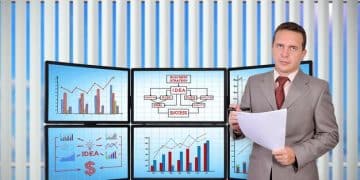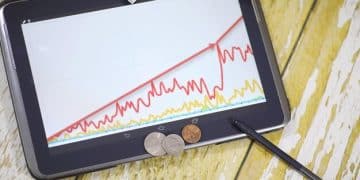Fed Rate Hike in Early 2025? Expert Analysis & Forecasts

Navigating the intricate landscape of the U.S. economy, experts are intensely debating whether the Federal Reserve will implement another interest rate hike in early 2025, considering persistent inflation, labor market dynamics, and global economic shifts to project potential monetary policy actions.
The question of whether the Fed will raise interest rates again in early 2025? Expert analysis and economic forecasts are at the forefront of financial discussions, captivating investors, businesses, and everyday citizens alike. As the economic landscape continues to evolve, understanding the potential trajectory of the Federal Reserve’s monetary policy is crucial for strategic planning and financial stability.
Understanding the Federal Reserve’s Mandate and Tools
The Federal Reserve, often referred to as “the Fed,” operates with a dual mandate: to achieve maximum employment and maintain price stability. These two objectives frequently intertwine and can sometimes present conflicting signals, making the Fed’s decisions complex and subject to intense scrutiny. Its primary tool for influencing the economy is the federal funds rate, a target rate for interbank lending that serves as a benchmark for interest rates across the financial system.
Beyond the federal funds rate, the Fed also employs other instruments, such as quantitative easing (QE) or quantitative tightening (QT), to influence the money supply and long-term interest rates. These tools are deployed strategically to either stimulate economic growth or curb inflationary pressures, depending on the prevailing economic conditions and forecasts.
The Dual Mandate: Price Stability and Maximum Employment
Price stability means controlling inflation, preventing excessive price increases that erode purchasing power and create economic uncertainty. Maximum employment refers to an unemployment rate consistent with a healthy, growing economy, where most people who want to work can find jobs. Balancing these two objectives is a constant challenge for the Federal Reserve.
- Price Stability: The Fed typically targets an average inflation rate of 2% over the long run, as measured by the Personal Consumption Expenditures (PCE) price index.
- Maximum Employment: This is a more fluid concept, as the optimal unemployment rate can change over time due to structural shifts in the labor market.
- Policy Adjustments: When inflation rises above target, the Fed tends to raise interest rates to cool the economy; when unemployment is high, it often lowers rates to stimulate hiring.
Understanding these foundational principles is essential for interpreting the Fed’s actions and anticipating future monetary policy shifts. The decisions made in Washington have ripple effects that reach every corner of the global economy, influencing borrowing costs, investment decisions, and consumer spending habits. The interplay between inflation, employment, and the Fed’s response mechanisms forms the core of economic forecasting.
The transparency of the Fed’s communications, through speeches from Fed officials, meeting minutes, and economic projections, offers critical insights into their thinking. Market participants closely monitor these communications for clues regarding the central bank’s future intentions. Any shift in rhetoric can trigger significant market reactions, underscoring the importance of staying informed.
Analysis of Current Economic Indicators: Inflation and Labor Market
The current economic climate is characterized by a complex interplay of forces, making the Fed’s task particularly challenging. Inflation, while showing signs of moderating from its peak, remains a key concern. The labor market, on the other hand, has demonstrated remarkable resilience, defying expectations of a significant slowdown. These two pillars of the Fed’s dual mandate provide conflicting signals that warrant careful consideration.
Examining the latest inflation data reveals a mixed picture. While some components, particularly goods prices, have seen significant deceleration, services inflation remains sticky. This stickiness is often attributed to strong wage growth and robust consumer demand, which continue to put upward pressure on prices in sectors like healthcare, housing, and entertainment. The Federal Reserve’s preferred measure, the PCE price index, is closely watched for signs of sustained movement towards the 2% target.
Inflation Trends and Persistent Pressures
Analyzing inflation requires dissecting various components to understand underlying trends. Energy prices and global supply chain issues initially drove much of the inflationary surge. However, as these factors normalize, the focus shifts to domestically driven inflation, particularly in the services sector.
- Core Inflation: Excluding volatile food and energy prices, core inflation provides a clearer picture of underlying price trends, often remaining elevated even as headline inflation cools.
- Wage Growth: Strong wage growth, particularly in service industries, can feed into higher prices as businesses pass on increased labor costs to consumers.
- Consumer Spending: Resilient consumer spending, supported by accumulated savings and a strong job market, can maintain demand-side inflationary pressures.
The labor market, surprisingly robust given the aggressive rate hikes to date, continues to be a source of strength for the U.S. economy. Job growth, while slowing from its pandemic-era highs, remains steady, and the unemployment rate hovers near historic lows. This tight labor market contributes to wage growth, which, as mentioned, can be both a positive for workers and a potential driver of inflation.

Furthermore, labor force participation rates are gradually recovering, but skill mismatches in certain sectors continue to contribute to wage pressures. The balance between job openings and available workers is a critical metric the Fed monitors to gauge labor market tightness.
The combination of persistent, albeit moderating, inflation and a strong labor market puts the Fed in a delicate position. Raising rates further risks slowing down an otherwise healthy labor market too much, potentially leading to a recession. Conversely, stopping too soon could allow inflation to re-accelerate, undoing previous progress. This balancing act is central to current economic discussions.
Expert Forecasts for Early 2025 Interest Rates
The question of whether interest rates will rise again in early 2025 is met with a spectrum of opinions from leading economists and financial institutions. While there isn’t a unified consensus, several dominant themes emerge, influenced by projections for inflation, economic growth, and global events. These expert forecasts often diverge on the timing and magnitude of potential policy shifts.
Many economists predict that by early 2025, the Fed will likely be in a holding pattern, assessing the cumulative effects of past rate hikes. The prevailing view among a significant portion of analysts suggests that if inflation continues its downward trajectory towards the 2% target, and the labor market shows some signs of cooling without a significant increase in unemployment, the Fed might opt to maintain current rates or even consider modest cuts towards the latter half of 2025 rather than further hikes.
Diverse Perspectives on Rate Trajectories
Different institutions employ various models and assumptions, leading to varied conclusions. Some forecasts focus on the inertia of inflation, suggesting that stickier elements might require the Fed to remain vigilant. Others emphasize the lagged effects of monetary policy, arguing that the full impact of previous hikes is yet to be realized, making further tightening unnecessary.
- “Higher for Longer” Camp: This group believes that underlying inflationary pressures, fueled by structural changes and fiscal policies, will keep inflation above target, necessitating rates to stay elevated or even increase slightly if challenges arise.
- Soft Landing Advocates: Many expect the Fed to successfully navigate a “soft landing,” where inflation returns to target without a severe recession, implying stable or slightly lower rates by early 2025.
- Hard Landing Concerns: A minority warns of a potential hard landing, where aggressive tightening triggers a recession, forcing the Fed to cut rates significantly earlier than anticipated.
Forecasting monetary policy also involves considering various “what-if” scenarios, such as geopolitical shocks, unexpected shifts in commodity prices, or significant changes in consumer confidence. These external factors can quickly alter the economic outlook and consequently, the Fed’s stance.
The Fed itself provides “dot plot” projections, offering a glimpse into the individual expectations of its committee members regarding future rate paths. While not binding, these projections serve as a valuable indicator of the collective thinking within the central bank. Early 2025 projections from the dot plot will be crucial to understanding the Fed’s inclination.
In summary, while a clear consensus is elusive, the dominant narrative leans towards the Fed exercising caution and monitoring data closely. Further rate hikes in early 2025 seem less likely if current trends hold, with an eye towards potential easing if economic conditions warrant it later in the year.
Geopolitical Factors and Global Economic Impact
The U.S. economy does not operate in a vacuum; it is deeply intertwined with global economic and geopolitical developments. These external factors can significantly influence the Federal Reserve’s decisions regarding interest rates. Events across the globe, from international conflicts to shifts in trade relations, can impact inflation, economic growth, and financial market stability within the United States.
For instance, ongoing geopolitical tensions in various regions of the world can disrupt supply chains, directly affecting commodity prices, particularly oil and gas. Spikes in energy costs can fuel inflation, presenting a challenge for the Fed’s price stability mandate. Conversely, a global economic slowdown could dampen demand for U.S. exports and services, potentially impacting domestic growth and employment.
Interconnectedness of Global Stability and U.S. Policy
The stability of major economies like China and the Eurozone also plays a crucial role. A significant slowdown in China, for example, could reduce global demand and commodity prices, which in turn might ease inflationary pressures in the U.S. However, it could also trigger a broader global downturn, impacting corporate earnings and investment sentiment.
- Energy Market Volatility: Geopolitical events often lead to swings in oil and gas prices, directly influencing inflation and consumer spending.
- Supply Chain Resilience: Disruptions to global supply chains, stemming from conflicts or natural disasters, can create bottlenecks and higher input costs for U.S. businesses.
- Currency Valuations: Interest rate differentials between the U.S. and other major economies can affect the dollar’s value, impacting import/export costs and inflation.
Furthermore, the monetary policy actions of other major central banks, such as the European Central Bank (ECB) or the Bank of England (BOE), can also influence the Fed’s strategy. Divergent policy paths may lead to currency fluctuations and capital flows that need to be considered in a globalized financial system.

The U.S. dollar’s role as the world’s primary reserve currency means that the Fed’s decisions have international implications, affecting global financial conditions and emerging markets. A stronger dollar, driven by higher U.S. interest rates, can make dollar-denominated debt more expensive for foreign countries, potentially triggering financial stress abroad.
Therefore, when assessing the likelihood of a Fed rate hike in early 2025, it’s imperative to look beyond domestic indicators. The geopolitical landscape and the health of the global economy will undoubtedly feature prominently in the Federal Reserve’s deliberations, adding another layer of complexity to their already challenging decision-making process.
Impact of Election Cycles and Fiscal Policy on Fed Decisions
The U.S. political cycle, particularly presidential election years, can introduce an additional layer of complexity to the Federal Reserve’s monetary policy decisions. While the Fed is designed to be an independent body, insulated from political pressures, the broader political and fiscal landscape inevitably influences the economic conditions they aim to manage. Early 2025 follows a significant election year, potentially shaping fiscal priorities and market sentiment.
During election years, candidates often propose new fiscal policies, ranging from tax reforms to large-scale infrastructure spending. These proposals, if enacted, can have substantial impacts on aggregate demand, inflation, and government debt, all of which are critical considerations for the Fed. For instance, expansionary fiscal policies could exacerbate inflationary pressures, potentially pushing the Fed towards a more hawkish stance.
Navigating Political Headwinds and Fiscal Direction
The Fed’s independence is crucial for its credibility, but it must operate within the prevailing economic reality shaped by fiscal decisions. A new administration might signal a shift in economic priorities, which the Fed would need to incorporate into its outlooks without overtly commenting on political outcomes.
- Fiscal Policy Impact: Changes in government spending or taxation can directly influence aggregate demand, employment levels, and inflationary trends, prompting a Fed response.
- Market Sentiment: Political uncertainty or clarity post-election can sway investor confidence, affecting financial markets and the broader economy, which the Fed monitors.
- Potential for Conflict: While independent, the Fed’s actions can be perceived differently by political factions, making communication strategies even more critical during these periods.
Another aspect is the potential for political rhetoric itself to influence market expectations. Public statements regarding economic conditions or the Fed’s actions, even if not directly influencing the central bank’s decisions, can affect consumer and business confidence, altering spending and investment patterns.
The Fed often adheres to a strategy of demonstrating its independence, especially during politically charged times, to maintain its neutral standing. This means focusing purely on economic data and its dual mandate, regardless of the political calendar. However, the economic outcomes of political decisions are undeniable.
Therefore, heading into early 2025, the fiscal policy framework established by the post-election government will be a significant input into the Fed’s models. Any large-scale spending programs or significant tax changes could alter the path of inflation and growth, making the Fed’s job of forecasting and calibrating interest rates even more challenging.
Historical Precedents and Future Projections: Lessons Learned
To anticipate whether the Fed will raise interest rates again in early 2025, it’s often insightful to look back at historical precedents. The Federal Reserve has a long history of responding to economic challenges, and while each economic cycle is unique, recurring patterns and lessons can be drawn from past policy decisions. Understanding these patterns helps contextualize current debates and informs future projections.
For example, periods of high inflation in the 1970s and early 1980s, followed by aggressive rate hikes under Paul Volcker, demonstrated the Fed’s willingness to act decisively to restore price stability, even at the cost of a temporary recession. More recently, the Fed’s response to the 2008 financial crisis and the COVID-19 pandemic showcased its capacity for unconventional monetary policies, including quantitative easing and near-zero interest rates.
Drawing Wisdom from Past Economic Cycles
The current environment shares some similarities with previous cycles but also presents new challenges. The post-pandemic inflation surge, for instance, involved unique supply-side disruptions combined with strong demand, echoing some aspects of past inflationary periods but with distinct characteristics.
- Inflationary Spirals: History shows that unchecked inflation can become entrenched, requiring significant policy interventions to bring under control.
- Lagged Effects: Monetary policy actions typically operate with a lag, meaning the full impact of current rate hikes might not be felt until well into 2025.
- Data Dependency: The Fed has consistently stressed its data-dependent approach, adapting policies in response to incoming economic information rather than adhering to rigid forward guidance.
One key lesson from history is the importance of central bank credibility. Erratic or unpredictable policy shifts can undermine public trust and make it harder for the Fed to achieve its objectives. Therefore, transparent communication and a consistent approach, even through challenging times, are paramount.
Looking ahead to early 2025, projections often hinge on how closely the current situation mirrors or diverges from these historical benchmarks. If inflation proves more stubborn than anticipated, drawing parallels to persistent inflationary periods of the past might push the Fed towards further tightening. Conversely, if the economy shows signs of a more significant slowdown, precedents from recessionary periods might advocate for holding rates steady or even cuts.
Ultimately, while history provides a valuable framework, the uniqueness of each economic moment requires flexible and adaptive policymaking. The Fed’s projections for early 2025 will be a synthesis of historical lessons, current data, and forward-looking economic models, all aimed at achieving its dual mandate in an evolving global landscape.
Preparing for Potential Rate Adjustments: Strategies for Businesses and Consumers
Regardless of whether the Fed raises interest rates again in early 2025, the current environment of elevated rates and economic uncertainty necessitates careful planning for both businesses and consumers. Adapting to potential adjustments in monetary policy is crucial for maintaining financial stability and capitalizing on opportunities. Proactive strategies can mitigate risks and position entities for resilience.
For businesses, higher interest rates translate into increased borrowing costs, affecting everything from expansion plans to working capital. Therefore, reviewing debt structures, exploring refinancing options where rates might be more favorable, and optimizing cash flow management become critical. Businesses should also stress-test their budgets against various interest rate scenarios to understand their vulnerability.
Strategies for Financial Resilience
Consumers also feel the direct impact of rate adjustments through mortgages, car loans, credit card rates, and savings accounts. Understanding how changes in the federal funds rate trickle down to personal finances allows for informed decision-making regarding debt management and investment.
- For Businesses:
- Debt Management: Prioritize paying down high-interest debt and consider fixing rates on variable loans if stability is desired.
- Cash Flow Optimization: Enhance inventory management, accelerate receivables, and negotiate better payment terms with suppliers.
- Investment Strategies: Re-evaluate capital expenditure plans against higher borrowing costs; focus on investments with clear, short-term returns.
- For Consumers:
- Debt Reduction: Prioritize eliminating high-interest credit card debt and personal loans.
- Savings and Investments: Explore high-yield savings accounts and certificates of deposit (CDs) that benefit from higher rates.
- Mortgage Review: For those with adjustable-rate mortgages (ARMs), understand potential payment increases; fixed-rate mortgages offer payment stability.
Beyond direct financial implications, potential rate adjustments can also influence consumer spending patterns and overall market demand. Businesses should monitor these shifts and be prepared to adjust their pricing strategies and product offerings accordingly. Flexibility and responsiveness are key attributes in uncertain economic climates.
For individuals, diversifying investment portfolios and considering professional financial advice can provide a buffer against market volatility. Furthermore, building an emergency fund remains a cornerstone of personal financial planning, offering a safety net against unexpected economic headwinds.
In essence, whether the Fed tightens or loosens its monetary policy, the period leading up to and through early 2025 demands vigilance and adaptability. By understanding the potential impacts of interest rate changes and implementing robust financial strategies, both businesses and consumers can navigate the economic landscape with greater confidence and resilience.
| Key Point | Brief Description |
|---|---|
| 📈 Inflationary Pressures | Inflation showing moderation but remains above target, particularly in services, posing a challenge for the Fed. |
| 💼 Resilient Labor Market | Strong job growth and low unemployment continue to fuel wage increases, contributing to enduring demand. |
| 🌐 Geopolitical & Fiscal Influence | Global events and post-election fiscal policies significantly impact economic trends and Fed considerations. |
| 🔍 Expert Consensus | General expectation favors a “hold” or potential cuts later in 2025, rather than further hikes, conditional on data. |
Frequently Asked Questions About Fed Interest Rates in Early 2025
The Federal Reserve considers interest rate hikes primarily to combat inflation, aiming to cool down an overheated economy. By making borrowing more expensive, the Fed can reduce consumer spending and business investment, thereby slowing the rate at which prices are increasing and working towards its 2% inflation target, a core part of its mandate for price stability.
Interest rate hikes directly impact consumers by increasing the cost of borrowing for mortgages, car loans, and credit cards. Conversely, they can lead to higher returns on savings accounts and Certificates of Deposit (CDs). These changes influence spending habits and can affect overall financial planning, making debt management a critical consideration for households.
The Fed primarily prioritizes inflation data, particularly the Personal Consumption Expenditures (PCE) price index, and labor market indicators, such as the unemployment rate and job growth. It also closely monitors wage growth, consumer spending, business investment, and global economic developments, all of which provide a comprehensive picture for monetary policy adjustments.
“Sticky inflation” refers to components of inflation, often in the services sector, that tend to decline slowly even as other prices moderate. This persistence is concerning to the Fed because it suggests underlying inflationary pressures that are harder to dislodge, potentially requiring rates to remain higher for longer to bring inflation back to its target.
Absolutely. Geopolitical events, such as international conflicts or significant shifts in global trade, can disrupt supply chains and impact commodity prices, especially energy. These events can exacerbate inflationary pressures or, conversely, trigger global economic slowdowns, directly influencing the Fed’s decisions as it balances its dual mandate against external shocks.
Conclusion
As we approach early 2025, the trajectory of Federal Reserve interest rates remains a focal point for economic observers. The intricate dance between persistent inflation and a resilient labor market, coupled with the unpredictable influences of global geopolitics and evolving fiscal policies, paints a picture of careful deliberation ahead. While a definitive answer remains elusive, the prevailing expert analysis suggests a cautious approach from the Fed, prioritizing data dependency over predetermined paths. Future decisions will largely hinge on the continued moderation of inflation, any cooling in the labor market, and the stability of the broader economic landscape. Both businesses and consumers are advised to remain agile, adapting their financial strategies to a climate where monetary policy adjustments, whether hikes, holds, or even eventual cuts, will significantly shape the economic future.





